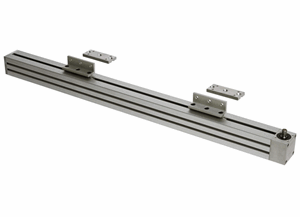Bishop-Wisecarver Corp
Double Acting Actuators

A pneumatic, or air, cylinder is a mechanical device, which produce force in combination with movement. They are typically powered by compressed air. To perform their intended function, the cylinders create a force by converting the compressed gas (air) into kinetic energy. The gas is able to expand, without external input. The gas is at a greater press than the atmospheric pressure. The air expansion allows the piston to move in a certain direction. The piston is usually a cylinder or disc; the piston rod forces the object to move. Once it is actuated, the compressed air enters the tube at one end of the piston, imparting force; the piston moves by the gas and expands, attempting to reach atmospheric pressure. Double acting actuators use the strength of the air to extend and retract the strokes. They have two ports that allow air in: one for outstroke, and one for instroke. Basically, it pushes the energy in two separate directions.
The double acting actuator cylinders come in a variety of sizes and typically range from small (2.5 mm diameter) to large (400 mm diameter.) The small sizes can be used for things like a transistor or electronic component. The large can be used for lifting cars. There are some instances where a leak of hydraulic oil could be an extreme hazard; these can typically be up to 1000 mm in diameter. These systems are generally used when system failures, however brief, are unacceptable. Sometimes, locks serve as safety mechanisms, in case of air supply or air pressure failure. The cylinders typically use glass pistons. They do not need lubricant.
The diameter of the piston and the force exerted by a cylinder are not directly proportional to each other in the double acting actuator. The mathematical component assumes that the air supply doesn’t become saturated. There is a cross-sectional area that is reduced by the area of the piston rod. This results in the instroke force being less than the outstroke force. The formula for finding the force, based on pressure and radius is F = p(pr2).
When selecting double acting actuators for your application, there are some considerations to keep in mind before choosing, like the diameter size you need. Generally speaking, the bigger the diameter, the greater the force. Also, rod length will dictate how far you will be able to move the object. Ensure that you have the correct fittings for the cylinder ports. If you need to control the cylinder speed, you will need to have flow controls in place.
Overview
The DAPDU2 belt driven unit is a double acting system that is ideal for driving automatic doors in use on spray booths and other manufacturing applications. The unit is built on a slotted, tough aluminum beam of one-piece construction. The beam is available in lengths to 6m, and incorporates a drive belt and two or more carriages running inside. This configuration effectively seals the unit on three sides.
- Carriages run symmetrically, achieving speeds to 6m/s
- Total driving force of 280N
The DAPDU2 double acting actuator integrates easily with the PDU2 line, which offers a full range of accessories and options including gearing, optional couplings, motor/gearbox mounting kits, T-nuts and brackets. DAPDU2 is also fully compatible with MCS aluminum framing.
Carriages
The carriages are the same Herculane® wheels used in the popular PDU2 unit, and provide excellent load capacity, durability, speed and quiet operation. The wheels run virtually friction-free on the inside surface of the profile, and provide stable support for the carriage plate. Maximum carriage capacity is 500N.
Click here for more Product Details from
Bishop-Wisecarver Corp...